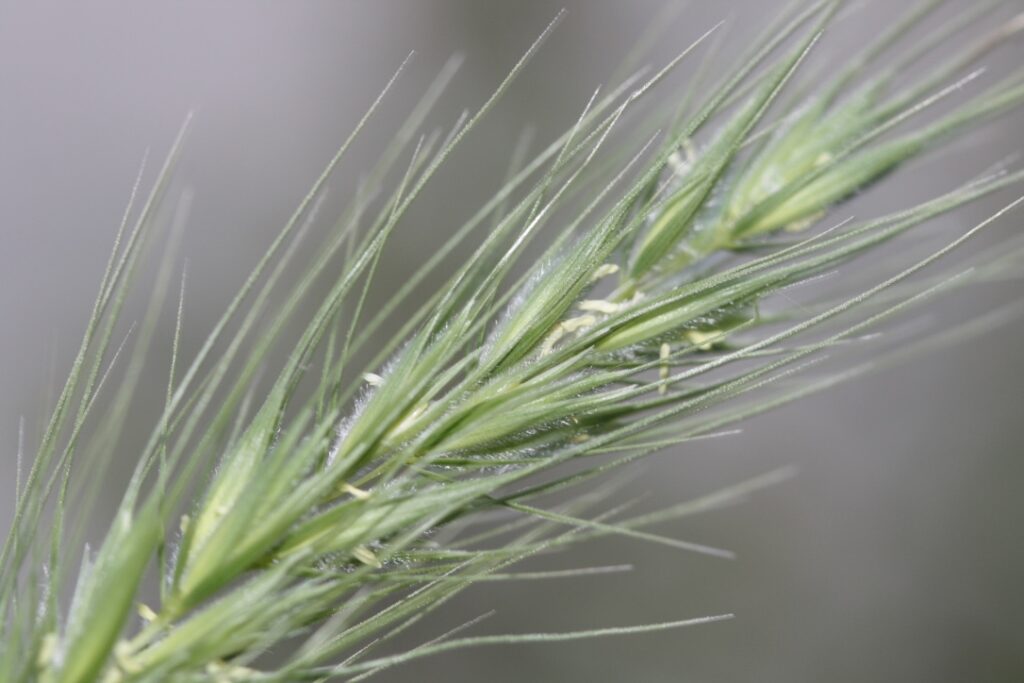Canada Wild Rye – Elymus canadensis L.
Tribe Triticeae

Synonyms or Other Names:
- Clinelymus canadensis
- Elymus brachystachys
- Elymus canadensis ssp. brachystachys
- Elymus canadensis ssp. hirsutus
- Elymus canadensis ssp. glaucifolius
- Elymus canadensis ssp. robustus
- Elymus canadensis ssp. villosus
- Elymus canadensis ssp. wiegandii
- Elymus crescendus
- Elymus glaucifolius
- Elymus philadelphicus
- Elymus philadelphicus ssp. hirsutus
- Elymus robustus
- Elymus wiegandii
- Hordeum canadense
- Hordeum patulum
- Roegneria canadensis
- Sitanion brodei
- Terrellia canadensis
This plant is also known as Canadian Wildrye, Prairie Wildrye, Nodding Wildrye, and Great Plains Wildrye.
Origin & Status
Common. Native to North America.
Notable Features to Identify:
E. canadensis is a tufted (bunch-grass) cool-season perennial that grows between 1 to 1.5 m tall; it rarely bears rhizomes, and if any, they are quite short (up to 4 cm long).
Leaves are flat or folded, 7 to 15 mm wide and 5 to 40 cm long. They are stiff, ascending to fine points, with a roughened surface above and prominent midveins below. Leaf margins are finely toothed. Sheaths are round, glabrous, and rarely pubescent. Ligules are truncate, lacerate-jagged, rarely hair-fringed, and membranous (0.5 to 2 mm long). Auricles are well-developed, finger-like, and clasping, 1 to 4 mm long.
Inflorescence is a spike 8 to 25 cm long, erect to arching, somewhat linear in shape, thick, bristly, and occasionally interrupted at the base. Spikelets are clustered 2 to 4 per node, overlapping and slightly spreading, with rachises not readily disarticulating or spreading at flowering. Spikelets are 1.2 to 1.5 cm long with 2 to 5 florets per spikelet; lemmas are broad at the base, 8 to 12 mm long, scabrous or hirsute (with stiff hairs). Glumes are subequal (1 to 2.4 cm long, 0.8 to 1.5 mm wide), awl-shaped, with 3 to 7 glabrous, scabrous, or ciliate veins. Lemmas are awned (1.5 to 5 cm long), outward-curved or flexuous, and become even more so (more widely spreading) at maturity. Glumes taper into awns (1 to 3 cm long); all awns on this species appear arching to somewhat straight.
When & Where to Find This Plant:
E. canadensis is commonly found in the prairie and parkland ecoregions. It prefers sandy soils in grasslands and dunes, such as those on shores or stream banks. This plant can also be found in disturbed areas, open woodlands, fence lines, and ditches, almost always in open areas or areas with shade for part of the day. It is adapted to a wide range of dry and moist soils, so you will likely find it near wetlands and possibly in the drier uplands.
Typically blooms from May to July, depending on the region. This plant will bloom earlier in the southern areas than in the northern regions.
Is This Species Edible, Medicinal, or Toxic?
E. canadensis has more value to livestock and wildlife than to people. It is largely edible, however it is susceptible to ergot infection of the inflorescences.
Ergot is a fungal infection where spores can infect a grass while flowering. The black ergot bodies that result when plants mature can, when ingested, cause a range of issues in livestock, from infertility to gangrene of feet, tail, and ears. Ergot has also historically been known to be dangerous to humans. Other wild rye species are susceptible to ergot; such is the case with many grass species, both tame and native.
Awns of this grass can also pose issues to livestock and other animals, like dogs. Awns are coarse and can easily poke the eyes of an animal or even lodge up their nose, causing serious injury.
What Other Species Can This Be Confused With?
It can be confused with most other wild rye species, such as Hairy Wild Rye (Leymus innovatus), Russian Wild Rye (Elymus junceus), Smooth Wild Rye (Elymus glaucus), and others. The key to preventing confusion between these species is the presence of long awns characteristic of E. canadensis. Most wild rye species lack this characteristic, or their awns are half the length.
It’s worth noting, however, that this species will cross-polinate with other Elymus species creating new crossbreds. It is largely self-pollinated, but cross-pollination will happen.
Other Fascinating Information
Canada Wild Rye is found in the south and eastern United States, from East Texas to the east coast north of Florida and from New York State/Michigan/Iowa southward, attracts a lovely little butterfly called the Zabulon Skipper (Poanes zabulon). Unfortunately, Canada is too far north of its normal range.
Value to Livestock & Wildlife
The forage value of this species is good to fair for most livestock and wildlife; it is better in quality while it is green and growing during spring or early summer, with forage quality quickly declining as it matures. While it is deemed an “increaser” in rangelands, it can decline under heavy utilization and border-line overgrazing.
Birds and small mammals will readily eat the seeds. Small birds use the long awns, glumes and lemmas as nesting material.
Suitability/Use for Reclamation
It is good use for reclamation as seeds are commercially available for use in native grass seed mixtures. It propagates fairly quickly and is suitable for soils with good moisture and areas with part-shade.
Gallery
Coming soon!